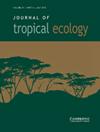厄尔尼诺振荡影响反捕食者防御,改变新热带潮湿森林中草食性甲虫的生存
IF 1
4区 环境科学与生态学
Q4 ECOLOGY
引用次数: 0
摘要
摘要尽管由于气候变化,热带昆虫群落的复杂性和稳定性正在迅速下降,但人们对厄尔尼诺-南方涛动(ENSO)对其影响知之甚少。我们探讨了ENSO造成的局部气候波动对食草动物防御介导敌人相互作用的性能的影响。在一个分布广泛的热带雨林边缘群落中,我们量化了五个敌人集团在草食性甲虫Acromis sparsa未成熟阶段造成的死亡率。ENSO是甲虫死亡率的重要决定因素。在温暖、干燥的厄尔尼诺年份,甲虫的存活率下降。这是由于黄蜂对卵的寄生增加,从而降低了孵化率。此外,蚂蚁对甲虫幼虫的捕食增加了。在更潮湿、更凉爽的拉尼娜年份,苍蝇和黄蜂正在争夺幼虫猎物。去除母体防护或化学防护的实验揭示了哪些ENSO相关参数可以预测幼虫死亡率。在拉尼娜现象中,保护措施对社会黄蜂最有效,而在厄尔尼诺现象中,防护措施被证明最有效。发生了两种与ENSO相关的防御-敌人崩溃:(1)脱钩,即狭义防御适应的效力降低,从而增加死亡率;(2)失配,即狭义防守适应对非目标敌人的抵抗力进一步降低,从而提高死亡率。这些结果突出表明,对天敌的防御效果可以根据生物和非生物环境条件的不同而变化。ENSO事件将增加防御介导的相互作用的崩溃、敌人之间竞争的转变和物种损失。本文章由计算机程序翻译,如有差异,请以英文原文为准。
El Niño oscillations impact anti-predator defences to alter survival of an herbivorous beetle in a neotropical wet forest
Abstract Little is known about the effects of El Niño-Southern Oscillation (ENSO) on tropical insect communities, even though they are suffering rapid declines in complexity and stability due to climate change. We explore the impact of fluctuations in local climate imposed by ENSO on the performance of herbivore defences mediating enemy interactions. In a widespread rainforest edge community, we quantified the mortality caused by five enemy guilds on the immature stages of the herbivorous beetle, Acromis sparsa. ENSO was a significant determinant of beetle mortality. During warmer, drier El Niño years, the survival of beetles decreased. This was due to increased egg parasitism by wasps, which reduced hatching. Additionally, ant predation on beetle larvae increased. Flies and wasps were in competition for larval prey in wetter, cooler La Niña years. Experimental removal of maternal guards or chemical shields revealed which ENSO-related parameters predicted larval mortality. Guarding was most effective against social wasps in La Niña, whereas shields proved most effective in El Niño. Two ENSO-related defence–enemy breakdowns occurred: (1) decoupling whereby the efficacy of a narrow defensive adaptation was reduced to increase mortality, and (2) mismatching whereby the resistance of a narrow defensive adaptation against non-targeted enemies was further reduced to increase mortality. These results highlight that defence efficacy against natural enemies can vary predictably with biotic and abiotic environmental conditions. ENSO events will increase breakdowns in defence-mediated interactions, shifts in competition among enemies, and species loss.
求助全文
通过发布文献求助,成功后即可免费获取论文全文。
去求助
来源期刊

Journal of Tropical Ecology
环境科学-生态学
CiteScore
2.10
自引率
0.00%
发文量
44
审稿时长
18-36 weeks
期刊介绍:
Journal of Tropical Ecology aims to address topics of general relevance and significance to tropical ecology. This includes sub-disciplines of ecology, such as conservation biology, evolutionary ecology, marine ecology, microbial ecology, molecular ecology, quantitative ecology, etc. Studies in the field of tropical medicine, specifically where it involves ecological surroundings (e.g., zoonotic or vector-borne disease ecology), are also suitable. We also welcome methods papers, provided that the techniques are well-described and are of broad general utility.
Please keep in mind that studies focused on specific geographic regions or on particular taxa will be better suited to more specialist journals. In order to help the editors make their decision, in your cover letter please address the specific hypothesis your study addresses, and how the results will interest the broad field of tropical ecology. While we will consider purely descriptive studies of outstanding general interest, the case for them should be made in the cover letter.
 求助内容:
求助内容: 应助结果提醒方式:
应助结果提醒方式:


